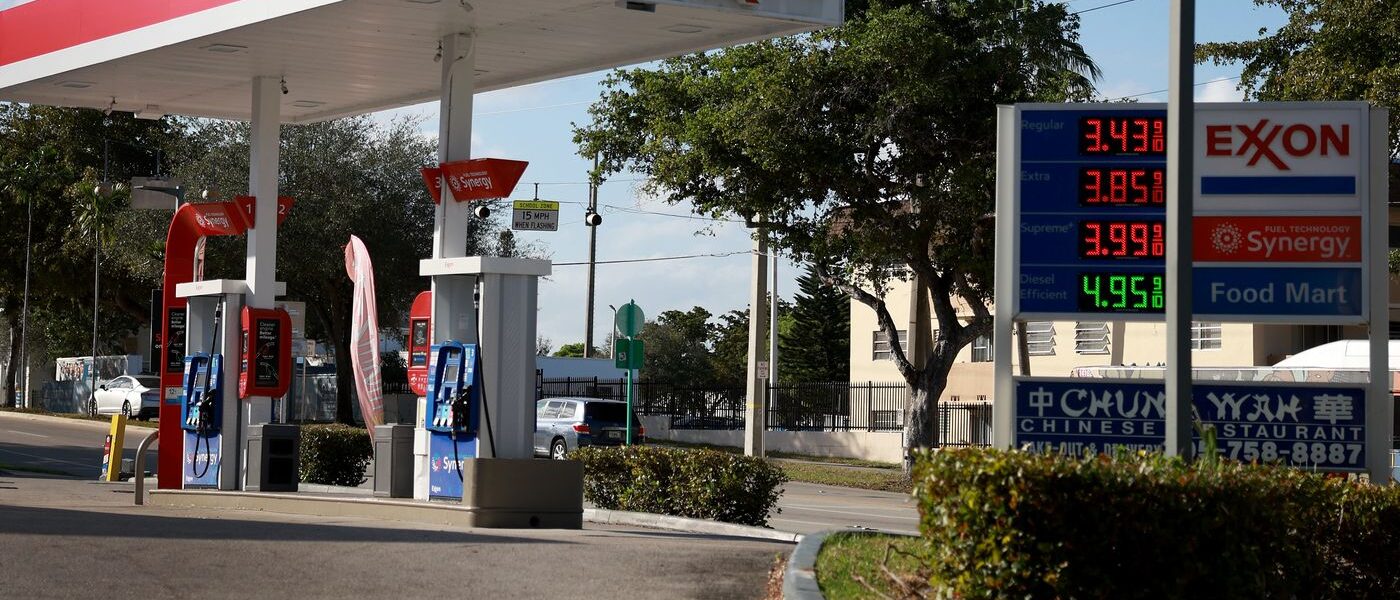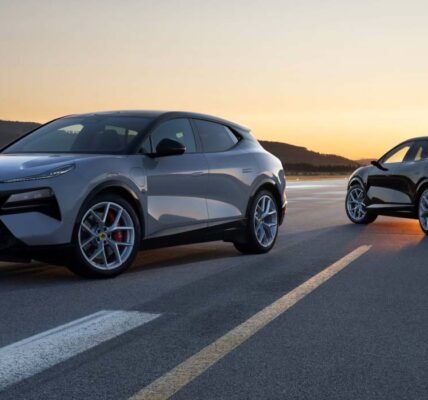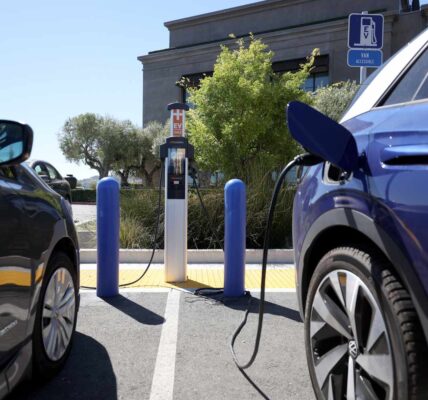Gasoline sales appear to have peaked for good in the United States.
Even as the pandemic fades and more Americans travel, changes to society and growing sales of electric and hybrid cars mean people are fueling up less often. Gasoline certainly isn’t going away, but starting in late 2019 the fuel that powered America for a century began a long drive into the sunset.
Americans used about 8.8 million barrels a day of gasoline in 2022, down from 9.3 million in 2019, according to the Energy Information Administration, the research arm of the U.S. Energy Department. The pandemic obviously complicated the picture, but recent stats have made the trend clear. So far in 2023, demand has continued to fall, dropping 1% from last year’s levels over the past four week period. Increasingly, analysts see little chance of it ever rebounding to its previous highs.
There are a few factors behind the shift, and working from home is clearly one of them. That trend has eased since 2020, but millions fewer people commute into offices every day than in 2019. More than half of Americans had the option to work from home at least once a week as of last year, and 35% could do it five days a week, according to a McKinsey survey.
That shift is a significant factor in the decline in gasoline consumption, according to Tom Kloza, the global head of energy analysis at the Oil Price Information Service, or OPIS. It also didn’t help that gasoline prices were so high last year. “Last year, there was that false prediction that everybody was so tired of Covid, they wanted to hit the road. But I think that they didn’t want to hit the road when gas prices went to $5 a gallon,” Kloza said in an interview.
Pain at the pump can’t explain much of the decline, however. If it was entirely due to high prices, then the recent drop in prices—to $3.40 a gallon now—would lead to a full rebound in demand. Other, more structural factors almost certainly had something to do with it.
Natasha Kaneva, the head of global commodities research at J.P. Morgan , estimates that high prices accounted for 45% of the decline in demand last year, while working from home accounted for 34%, and the shift toward electric and hybrid cars accounted for 19%. Kaneva pointed out in a recent report that Americans traveled more miles in 2022 than they did in 2021 but still used less gasoline. By September 2022, gasoline prices averaged $3.70 and Americans were traveling even more than they did before the pandemic—but gasoline demand still didn’t approach its past highs.
Kaneva expects a slight rebound later this year. She sees demand hitting 8.88 million barrels a day, up from 8.83 million last year. In 2024, it could get to 8.95. But she sees little chance of demand ever returning to the monthly peak of 9.85 million barrels that it hit in August 2019, or to the annual peak of 9.3 million barrels in 2018. If auto makers hit their electric vehicle production targets, gasoline demand is likely to fall to 7.4 million barrels a day by 2030, down 16% from 2022, according to Kaneva.
“Policies put into place more than a decade ago are now becoming visible in the data,” Kaneva wrote. “American drivers are traveling more miles on less fuel than ever before thanks to a generation of cars with more efficient engines as well as new electric vehicles.”
About 6% of passenger vehicles sold in the U.S. last year were electric and about 1% of vehicles on the road are now electric. That’s still a small number, but vehicle-efficiency standards have also taken a considerable bite out of gasoline demand and are expected to become even more stringent in the coming years. U.S. fuel economy standards are set to rise to 49 miles per gallon by 2026. People who buy new cars in 2026 will get 33% more miles to the gallon on average than if they bought a 2021 model—meaning they’ll only have to make three pit stops for gas on a trip where they now have to make four.
Even as U.S. gasoline demand declines, global demand has continued to grow, giving U.S. refineries new markets for their product. Refineries shipped a record 887,000 barrels of gasoline a day outside the U.S. in 2022, according to the latest estimates from the Energy Information Administration. That’s more than twice as much as they did a decade ago. Overseas markets may not buy that much gasoline forever, though. Electric vehicles are growing even faster outside of the U.S., taking up 14% of market share for light-duty vehicles worldwide in 2022, according to Raymond James analyst Pavel Molchanov. In China, they made up 30% of market share. The fast growth in sales of EVs surprised Molchanov. He had initially estimated 9.3 million EVs would be sold in 2022. Actual sales came in around 10.1 million.
Molchanov estimates that electric vehicle adoption has already shaved 1.5 million barrels off daily global oil demand, and will reduce global demand by 2.6 million barrels by 2025 and 7.4 million by 2030. About 25 million barrels of gasoline are used a day around the world today. Figuring out the direction of global gasoline demand, however, isn’t quite so simple as drawing a straight line going down. Even as electric vehicles eat into demand, other factors are causing it to rise. In parts of the world like India, population growth and increasing sales of total vehicles—gasoline and electric—should cause demand to keep increasing. Global gasoline demand could peak around 2025, when the sheer size of the electric-vehicle market starts making a bigger dent, Kaneva estimated last year.
Beyond gasoline, oil doesn’t look like it’s going away soon. Total global oil demand today is around 100 million barrels a day, and certain kinds of oil products, such as jet fuel, are growing in use. So even if gasoline and diesel demand falls due to electric vehicle adoption, there’s a good chance total oil demand will continue rising. In fact, Kaneva wrote last year that gasoline would likely be the only oil product to see falling demand between 2019 and 2030. Several analysts, including Molchanov, expect oil demand to rise for several years, before potentially plateauing around 2030. “The more interesting question is, after it peaks, what will be the rate of decline?” he said in an interview.
For companies throughout the oil supply chain, that question is crucial. It’s an even more urgent question for those that sell gasoline. Gas stations could fare differently based on their business models, Kloza of OPIS said. For “mom and pop” operations that often sell branded gasoline from companies like Exxon Mobil XOM –1.98% (ticker: XOM), the future looks more bleak. At those stations, gasoline is the main product, and side businesses selling things like cigarettes can’t necessarily make up the difference when gas sales fall. Volumes at the average station are down about 20% from 2019 levels, according to the latest stats from OPIS.
Stations connected to convenience businesses like Sheetz or Wawa could fare better, because a large portion of their sales come from ancillary items like food.
The companies that are best-positioned today, however, are big box stores that include discounted gasoline as part of their membership plans. Costco clearly picked up market share over the past year as people flocked to the store for cheaper gasoline. In fact, for the latest quarter, the company said it charged 37 cents per gallon less than the average station. The company has historically been willing to make thinner margins on gas because it’s such a big draw for new members. Costco may eventually have to think more about electric vehicles, but the company seems happy for now to focus on gasoline. Asked on a conference call last week if he’s concerned about the impact of the fast rise of EVs on gasoline sales, CFO Richard Galanti said that “the fact that we’re still taking such market share relative to U.S. gas gallons in general is a positive. So I think it’s a question that we can defer for five or 10 years, frankly.”
Changes in driving habits are unlikely to sink Costco, given all the other reasons people shop there. And the company could simply shift from cheap gas stations to cheap charging stations, particularly given that its largest market is California, where EVs are truly taking off. It has already installed some stations. Given current trends, it may need to consider expanding them sooner rather than later.








